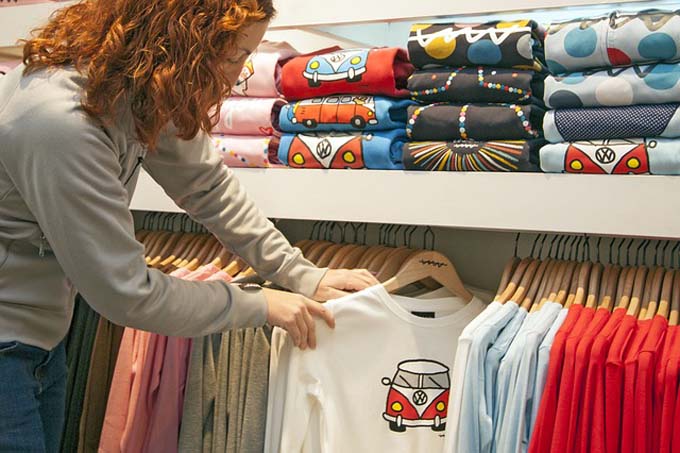Swiss trade sectors spread confidence
Handel Schweiz, the umbrella organization for the retail industry, conducted a survey of 19 retail sectors. It shows that only very few retail sectors, such as toys, wood and electric vehicles, enjoyed significantly growing sales in 2020. Most retailers had to contend with problems and, in some areas, sharp declines in sales. Nevertheless, confidence dominates in the retail sector.

Commerce has always been trimmed for flexibility. That's one of the reasons why Swiss retail industries have put up a brave fight overall in 2020, says Kaspar Engeli, director of Handel Schweiz, the umbrella organization for the retail industry: "Even outside of Corona, retail companies are faced with constant changes - from changing consumer behavior to problems in supply chains, price increases for raw materials or suppliers, and customs regulations that are suddenly adjusted."
Challenging year for all retail sectors
Nevertheless, 2020 was also an exceptionally challenging year for most retail sectors. However, individual areas achieved significant increases. These include toy retail, which grew by 13% in general and now sells almost 40% via online retail, which is on a par with our neighboring countries. Switzerland has thus caught up massively in just two years. Consumers are not only playing and doing more puzzles. They have also changed other preferences. Coffee cream, for example, is now mainly bought in larger bottles rather than in small portions. Mr. and Mrs. Swiss prefer to enjoy local wine, which has increased by 10%. They also used the time to plan and commission their wooden deck. As a result, sales in the trade in wood materials for wood construction increased by 20%. The drive technology of the new car was also a topic in Swiss families. In 2020, 30% more new cars with alternative drives such as electric were sold, in 2021 already 36% more. Home office and online meetings boosted sales of high-quality cameras. Textile trade was pleased with the good trend of workwear. Trade in machinery for the packaging industry also recorded an increase. In medical technology, the "Emergency" and "Anesthesia" segments were able to compensate somewhat for the slump in sales in other segments.
The assessments of the retail sectors in detail
For the Toysindustry, 2020 was a very good year with 13% higher sales. Delivery issues were a challenge. The shift from bricks-and-mortar retail to the Internet was enormous. Meanwhile, Switzerland has almost caught up with other Western European countries in this area. In 2021, this trend will continue and online trade will account for a good 40% of sales of toys.
Food the Swiss consumed largely unchanged overall in 2020. The temporary interruption in shopping tourism proved to be an advantage for local retailers. Some retail companies recorded a slight increase. The industry is looking ahead to 2021 with cautious optimism.
In the corona year 2020 was pleased the Wine trade about a good quality harvest and was able to fill the warehouses well. However, as is well known, wine is not consumed in closed restaurants. Therefore, the wine trade had to accept a decline in sales of up to 45% in the restaurant trade. Sales in the specialized trade also slumped by 45%, while the retail trade was able to increase. In January 2021, consumer sentiment was at a low point. However, there were signs of a slight recovery in February.
The Retail trade is very heterogeneously affected by the pandemic. The closure of thousands of stores over a period of weeks caused great difficulties for many retailers. In 2021, however, the retail trade as a whole is confident. A sigh of relief can be felt in the industry. One current challenge is overseas shipments, which are fraught with uncertainty, which can lead to merchandise shortages.
The trade with Photo and video cameras recorded an overall decline in sales for the year 2020. At the same time, there was a technology shift from SLR cameras to mirrorless devices. During the lockdown and in the home office, many professionals stocked up on high-quality cameras for video sessions. Now, this type of communication is widely accepted, which will lead to further user needs. For 2021, the trends are slightly negative, but the year is developing better than 2020.
The Textile trade was at a normal level in 2020; sales of textiles to retailers were stable. Trade in workwear continued to follow a positive trend. However, following the Corona restrictions in the fall, the winter collection is still in stores and warehouses and almost impossible to sell. Problems are also caused by the lack of containers for transport from the Far East and the massively increasing freight costs.
At Leather trade the development varied greatly depending on the region and customer groups. While some leather retailers saw no losses, others lost up to 40% in sales.
In specialized trade Cigars and luxury food sales declined by 20% in 2020, while Wholesale was able to maintain its volume. With 90% decrease, duty free underwent a dramatic development. Of concern is the potentially sustained decline in business travel. While sales in Asia are up slightly and the market in the U.S. is stable, business volume in Europe is down. Pricing and freight reliability are current challenges. Overall, the outlook for 2021 is nevertheless cautiously positive.
In the Medical Technology the areas developed very differently. While "Emergency" and "Anesthesia" recorded a plus in 2020, there were declines of up to 40% in surgery. As postponed operations are now being made up, the outlook for medical technology trading is normalizing in this respect. A major concern is the expiry of the Mutual Recognition Agreements MRA agreement with the EU. The EU has made it clear that it will not renew the MRA without the Institutional Framework Agreement.
Also the Trade with machines and automation for printing and Packing had to demonstrate great flexibility. While the packaging sector showed an above-average positive development, the printing press trade recorded a decline of 20%. For the current year, it is expected that the printing press trade will at least be able to maintain the current low level.
At Car trade the pandemic is causing rapid changes in the market. New car sales in 2020 slumped by 24% compared to 2019 - the worst performance since 1975, but the bright spot was provided by a 30% increase in sales of new cars with alternative powertrains. In January and February 2021, new car sales fell by 18%, with the share of new vehicles with alternative powertrains increasing further to 36%.
Also throughout the Building area the individual sectors developed very differently, affecting several trade sectors. While civil engineering continues at a high level, building construction is declining. Not only the Steel trade suffered in 2020 from delayed building permits, which were processed more slowly due to the home office of the building authorities. This fact slows down the overall development in the market. As construction is one of the drivers of the economy, the impact of this permit policy is felt in many other industries, including retail. This has also led to a difficult start in the current year.
The Interior design and event constructionwhich is suffering from the cancelled trade fairs, recorded a slump of around 10%. Uncertainties are also caused by the threatened postponement of public sector projects such as the SBB. Challenges lie in the price increases for steel, wood and plastics and the - hopefully only temporary - suspension of public sector projects. It is foreseeable that investments in the tourism sector will be restrained in the coming years.
However, despite these negative conditions, trading in particular with Wood materials satisfactory. Sales in the Wood construction increased by up to 20%. The pandemic provided a powerful boost to digitization in operational work. The outlook for 2021 is very good. Wood continues to be in vogue. The challenges lie more in material availability, price increases and high capacity utilization among producers.
Overall, the Metals trade 2020 a decline of up to 1.5%. Above all, demand from industry slumped. There was already a price increase last year, which continued in the first two months of 2021.
In trade with Construction machinery volumes declined by 6% last year. In 2021, the industry expects stable demand and a plus of 1.5%. Current challenges are the increased prices by up to 7%, longer delivery times and the EU tariffs for products from the USA.
In trade with Building materials business volumes remained stable, with regional differences such as in the Geneva region, where 15% fewer building materials were sold. In French-speaking Switzerland and Ticino, construction site closures caused problems, while on the other hand year-round factory closures led to delivery delays. In 2021, the building materials trade expects stagnation or a slight decline.
The Electrical Wholesale was able to stabilize sales in the construction industry by the end of 2020 following temporary sharp declines. In industry, on the other hand, it was not possible to make up for the initial drop in sales over the course of the year. At the beginning of 2021, sales are down by 5%, mainly due to the weather. Overall, sales in 2021 are expected to be similarly restrained to those in 2020.
The trade with Floor coverings recorded a decline of around 8% in 2020. A negative factor was that the usual renovations in the tourist regions were not possible in the spring or were postponed until the fall. In 2021, sales developed stably in the first two months. Irrespective of Corona, the trend continues that pure flooring suppliers will disappear more and more. Mergers with painting companies, for example, mean that in the future builders will be able to hire "small" general contractors for the interior, who will handle wall, floor and ceiling work from a single source.
Working platforms are used in construction, industry, cleaning and at trade fairs and events. Overall, most suppliers of work platforms or aerial lifts lost 12% in sales in 2020 compared to the previous year. The industry is feeling the impact of Corona, particularly through canceled events. In addition, unsettled customers are investing less, which has a negative impact on the sale of access platforms.
Source: Trade Switzerland









